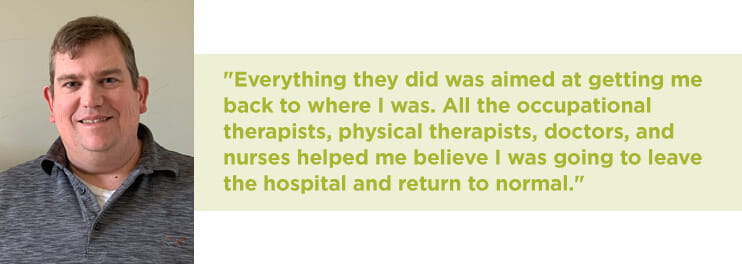Matt, a 47-year-old single father of three, thought the worst was behind him after a week-long hospital stay near his home for COVID-19. But 10 days after his release, the Sarver, Pa., resident continued to have COVID-related problems, including weakness and tingling in his hands and feet. Then he fell, tearing a muscle in his hip. This time, he went to UPMC St. Margaret where he was admitted into the UPMC Rehabilitation Institute’s inpatient rehab unit.
“I knew something was really wrong. I needed a higher level of care,” says Matt.
His rehab team did a thorough assessment and began a rehabilitation program aimed at treating Matt’s injury and rebuilding his strength. “Although his strength was pretty good, we were on the lookout for any change,” says Debbie Tan, MD, medical director at St. Margaret.
A Serious Setback
As a physiatrist trained in physical medicine and rehabilitation, Dr. Tan focuses on the “whole person,” not one organ or part of the body. She is aware of complications that can arise in recovering patients, including complications due to COVID 19.
Within days of his arrival, Matt couldn’t lift his hands or his arms. Dr. Tan immediately suspected acute inflammatory demyelinating polyneuropathy (AIDP) — a form of Guillain-Barré Syndrome that has been associated with COVID. She made arrangements for special neurological testing at UPMC Presbyterian that confirmed her diagnosis.
AIDP is a potentially life-threatening condition that can lead to paralysis, difficulty breathing, and the need for respiratory support. Because Matt was diagnosed early on, he was immediately started on intravenous immunoglobulin (IVIG) treatments. Given soon after the onset of symptoms, the treatment has proven effective in speeding recovery.
Matt returned to UPMC St. Margaret where he resumed rehab. He initially needed a special lift to move from his bed to a wheelchair but made quick progress. His rehab team focused on building strength, balance, and dexterity. The AIDP left him without any feeling in his feet or his hands. They taught Matt to visualize his feet and where they were positioned. His hands were like claws, so they worked on his fine motor skills. They also worked on activities of daily living — getting in and out of bed, toileting, dressing, and bathing.
“I went from being completely bedridden, to being able to sit up on my own, then stand on my own,” says Matt. “I was really excited about the way treatment was going.”

Another Serious Setback
Five days after his return from UPMC Presbyterian, Matt experienced chest pain. Scans revealed blood clots in his legs and a dangerous pulmonary embolism, or blood clot, in his lung. He was put on a blood thinner and moved to the acute care floor at UPMC St. Margaret.
After a week, Matt was given the okay to resume rehab.
“I was ecstatic. I was so happy to get back to work,” he says. “I knew how passionate everyone there was about helping people get better. It was the environment I needed to get better.”
Over the next three weeks, Matt’s progress accelerated. At first, he could only stand for 10 seconds and needed two or three people to help him walk. He later used a special harness for support while walking on a treadmill. Every day brought a new milestone: standing up from a wheelchair, standing on his own, taking steps, going from a walker to a cane, and going up and down stairs.
“When I broke the 100 steps mark, that was a big deal. Moving on to a cane was the next big step,” says Matt.
Because he’s a single dad, the team also worked on simulating everyday tasks — doing laundry, making simple meals, using stairs, and getting in and out of a car. Playing interactive video games and air hockey made rehab fun while also improving balance, hand-eye coordination, and endurance.
“Everything they did was aimed at getting me back to where I was,” says Matt. “All the occupational therapists, physical therapists, doctors, and nurses helped me believe I was going to leave the hospital and return to normal.”
Another Scare
Matt was close to being discharged when he experienced another scare — severe abdominal pain. But a CT scan showed it was a kidney stone that passed harmlessly.
It was just another example of the complete care he received during his hospital stay, he says. Dr. Tan, who managed his care, was quick to raise a flag and get other specialists involved when she suspected something was wrong.
“She always made sure I got the right treatment and care,” says Matt.
“I felt like I built a relationship with everyone in rehab. They took time to understand how I was feeling and picked up on things when something wasn’t right.”
Finally, on March 25 — 52 days after he was first admitted to inpatient rehab — Matt walked out of UPMC St. Margaret. He returned home to his children and in May returned to his full-time job as an electrical engineer.
“They told me I would walk out of there, and I did. It was amazing,” says Matt. “Words can’t express how grateful I am. How do you thank someone for giving you your life back?”
This patient's treatment and results may not be representative of all similar cases.
















